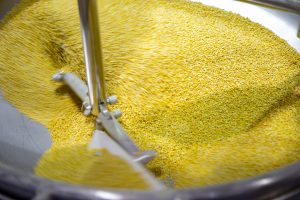
In the manufacturing process, production speed and product quality heavily depend on reliable material flow. That means materials flow smoothly, in a first in/first out pattern. However, bulk materials have a tendency to clump together, cling to vessel walls, or form large material blocks that restrict the discharge outlets. Flow can slow down, or even stop completely. Here are the most common types of material blocks, and the only flow aid you need to prevent them.
Bridging / arching
As the name implies, materials form a large bridge or arch right above the vessel outlet. This happens when the particles interlock and bond together, and need an external force to break it up and restore the flow.
There are two types of bridging or arching:
- Interlocking arch. The particles mechanically interlock, like pieces of a jigsaw puzzle.
- Cohesive arch. The particles are bonded together because of moisture, temperature, or the concentration of fines.
The strength of the bridge or the arch depends on the material’s inherent cohesive strength and the internal friction of the particles. For example, very fine powders like flour may respond to gentle aeration. However, cocoa powder or titanium dioxide—which has a tendency to clump and aggregate—will need more powerful, concentrated air pulses.
Ratholing
Ratholing occurs when materials accumulate along the vessel walls, leaving only a small flow channel right above the outlet. This creates two problems: the flow slows down, and stagnant material stays in the vessel. Without first in/first out flow, manufacturers run the risk of spoilage and contamination.
Furthermore, if the material has cohesive properties, it will cake and agglomerate instead of flowing out of the vessel. Eventually, the channel closes up and the flow completely stops.
Particle segregation
Granular materials can segregate because of differences in size, shape, and density. This can occur during crushing and grinding, transportation, storage, and mixing.
Segregation is especially critical in the chemical, pharmaceutical, and food industries when materials must be mixed in exact proportions to protect product integrity. For example, a supplement needs a precise balance of vitamins and minerals that is declared on the nutrition label—otherwise, the company could be slapped with a fine and be forced to recall entire batches that don’t meet the specs.
The “perfect” material flow
The gold standard of material flow is mass flow, which has the following characteristics:
- Steady, uniform flow with a consistent bulk density
- First in / first out – no stagnant material
- Controlled discharge rates with no issues of stopping or flooding
AirSweep: achieve reliable material flow
AirSweep is a pneumatic flow aid. It uses powerful, 360-degree air pulses to break apart material blocks and sweep material back into the flow stream.
And when material flows, so do productivity and profits.
- Reduce downtime from manually clearing material blocks or flushing vessels between product batches
- Improve product consistency and quality by preventing stagnant material and segregation
- Avoid material waste from throwing away contaminated material or inconsistent batches
AirSweep also lowers maintenance costs, because it uses less energy and does not damage vessels like other flow aids such as vibrators and fluidizers.
Get a customized proposal for your process
There is no “one size fits all” setup to prevent material blocks. We can customize an AirSweep system where nozzles are positioned at the right place, and release the right sequence of pulses, to move material efficiently.
Contact us to find out more about how AirSweep works, and how it can help improve your process.





Comments are closed